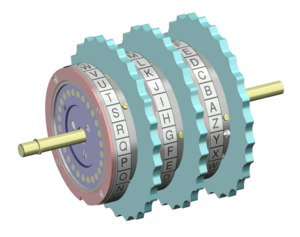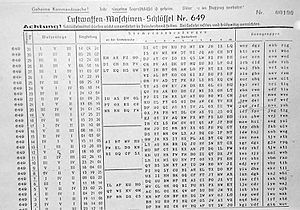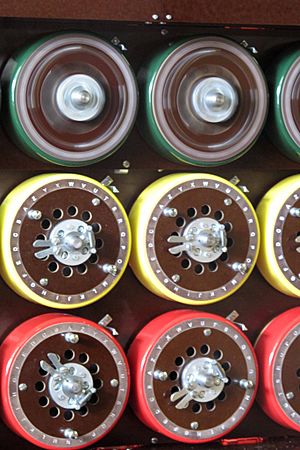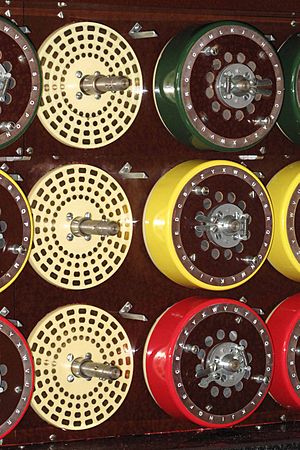Bombe facts for kids
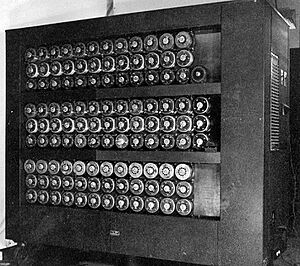
The Bombe was a special machine used by British codebreakers. It was an electro-mechanical device. Its job was to help figure out secret messages. These messages were sent by the Germans using their Enigma machine during World War II. The US Navy and Army later made their own versions.
The British Bombe was based on an earlier machine. This machine was called the "bomba". It was designed in Poland by a codebreaker named Marian Rejewski. He had been breaking Enigma messages for years. The first British Bombe was designed in 1939. This happened at Bletchley Park by Alan Turing. Gordon Welchman made an important improvement in 1940. Harold Keen built the machines. The first Bombe was called Victory. It was ready in March 1940. The second, Agnus Dei, was working by August 1940.
The Bombe's main goal was to find the daily settings of the Enigma machines. These settings included which rotors were used and their positions. It also found the starting positions for each message. And it helped figure out some of the plugboard connections.
Contents
What Was the Enigma Machine?
The Enigma was an electro-mechanical machine. It was used to encrypt and decrypt secret messages. Germany developed it in the 1920s. When you typed a letter, the machine changed it. This happened many times, making a secret code.
The Enigma had spinning parts called rotors. Each rotor had 26 electrical contacts. These contacts changed the path of electricity. When you pressed a key, electricity flowed. It went through the rotors. Then it hit a reflector. The reflector sent the current back through the rotors. Finally, it lit up a lamp, showing the coded letter.
Every time a key was pressed, the rightmost rotor moved. This changed the code. After a full turn, the right rotor moved the middle one. The middle rotor then moved the left one. Each rotor showed a letter in a window. Operators set these letters to start a message. This three-letter sequence was the "message key." There were 17,576 possible message keys.
Operators could also change the order of the rotors. They could pick three rotors from a set. This gave many more possible settings. For example, picking three from five rotors gave 60 different orders.
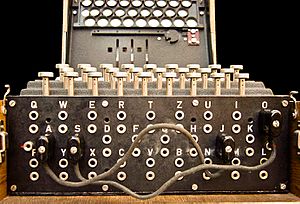
In 1930, the German army added a new security feature. This was a plugboard (Steckerbrett). It swapped letters before and after the main coding. This made the code much harder to break. With six plug leads, there were over 100 billion ways to set up the plugboard.
One key weakness of the Enigma was its reflector. It meant a letter could never be encrypted as itself. For example, 'A' could never become 'A'. This was a big clue for codebreakers. If their guess for a message had 'A' encrypting to 'A', they knew it was wrong.
Before World War II, the Germans improved their Enigma machines. By 1939, they used three rotors chosen from five or eight. This increased the possible settings a lot. Also, they used ten plugboard leads. This made the code even more complex. By 1941, the German navy used a four-rotor Enigma for U-boats. This machine had even more possible settings.
The Four-Rotor Enigma
By late 1941, the German Navy was having great success. They thought the Allies could not read their codes. So, they added a fourth rotor to their Enigma machines. This new system was called Triton by the Germans. At Bletchley Park, it was known as Shark.
Luckily for the Allies, a German submarine made a mistake. In December 1941, it sent a message with the fourth rotor in the wrong spot. Then it sent the same message again with the rotor in the correct spot. This helped the codebreakers. They figured out how the new rotors worked.
The first half of 1942 was tough for the Allies. German U-boats sank many ships. The US had just joined the war. They were not ready for the U-boat attacks. The new Enigma code was very secure. Also, the Germans could read some Allied messages. Between January and March 1942, U-boats sank 216 ships off the US coast.
The Allies eventually started using convoys. They also made coastal cities dim their lights. This made it harder for U-boats to spot ships. The Germans believed their Enigma code was safe. This was because Allied messages never mentioned breaking Enigma.
How the Bombe Worked
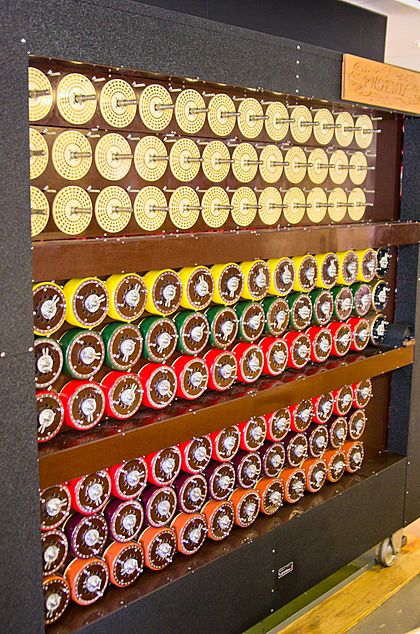
To break German Enigma messages, codebreakers needed to find certain settings. Once these were known, all messages for that day could be read.
Internal Settings (needed opening the Enigma machine):
- The choice of rotors and their order (called "wheel order"). This could be 60 or 336 different ways.
- The position of the alphabet rings on each rotor ("ring settings"). There were 26 settings for each rotor.
External Settings (could be changed without opening the machine):
- The plugboard connections ("stecker values"). There were trillions of ways to set these up.
- The starting positions of the rotors for each message ("message key"). There were 17,576 possible three-letter keys.
The Bombe found possible starting positions for the rotors. It also helped find some plugboard connections. Then, people used other methods to finish breaking the code. As Gordon Welchman said, the Bombe simply narrowed down the possibilities.
Bombe's Structure
The Bombe was an electro-mechanical machine. It copied how several Enigma machines worked together. A standard British Bombe had 36 parts. Each part acted like an Enigma machine. These parts had three drums. Each drum copied an Enigma rotor. A Bombe could work on two or three codebreaking tasks at once.
To act like Enigma rotors, each Bombe drum had two sets of contacts. One set was for electricity going in. The other was for electricity coming out. Each drum had 104 wire brushes. These brushes touched a plate. The brushes and contacts were in four circles of 26.
The Bombe drums were set up like the Enigma. The top drum copied the left Enigma rotor. The middle drum copied the middle rotor. The bottom drum copied the right rotor. An electric motor spun all the top drums together. For every full turn of the top drums, the middle drums moved one step. The bottom drums also moved one step. This allowed the Bombe to test all 17,576 possible rotor positions.
The drums were color-coded. This showed which Enigma rotor they copied. For example, Rotor I was red, Rotor II was maroon, and so on.
At each rotor position, the Bombe checked for an electrical current. If the test led to a problem, that setting was wrong. The machine would stop if the test did not cause a problem. This meant it found a possible solution.
The operator would write down the possible solution. Then, they would restart the machine. There were usually many false solutions. These were called "stops." Codebreakers then worked to remove the false stops. They would also figure out the plugboard connections. Finally, they would test the result on a modified Typex machine. This showed if the decrypted message was real German text.
Creating a Bombe Menu
To use a Bombe, a codebreaker first needed a crib. A crib was a guess about a part of the message. It was a section of plain text that they thought matched the secret message. Finding cribs was hard. It needed a lot of knowledge about German military talk. It also needed to know how operators usually sent messages.
Codebreakers were helped by the Enigma's weakness. A letter could never encrypt to itself. This helped them check cribs. If a crib had the same letter in the same spot as the coded message, it was wrong. This was called a crash.
Once a good crib was found, the codebreaker made a menu. This menu showed how to wire the Bombe. Let's say the crib was ATTACKATDAWN. The coded message was WSNPNLKLSTCS. The codebreaker compared the letters. They made connections between the coded and plain text. These connections were drawn as a graph, like in the diagram.
The more loops (or cycles) in the menu, the better. More loops meant the Bombe could reject more wrong settings. This led to fewer false stops.
The British Bombe's Development
The Polish bomba was useful for a while. But it needed certain conditions. The message key had to be repeated. Only three rotors could be used. And only a few plugboard connections could be made. When the Germans added more rotors and plugboard connections, the Polish machines struggled. Building more machines was too expensive for Poland.
Alan Turing designed the British Bombe differently. It used the idea of a "crib." This is when codebreakers guess what text might be in a message. This method is called a known plaintext attack. The Poles had used it a little. For example, Germans often used "ANX" (AN for "To," X as a spacer).
A budget of £100,000 was set for building Turing's machine. The British Tabulating Machine Company (BTM) built the Bombes. Harold 'Doc' Keen led the project. Each machine was large. It was about 7 feet wide, 6.5 feet tall, and 2 feet deep. It weighed about a ton.
On the front, each Bombe had 108 places for drums. These drums were in 12 groups of three. Each group of three copied the three rotors of an Enigma. The Bombe drums were connected by cables. This allowed them to be wired according to the menu. The fastest drum spun at 50.4 revolutions per minute. Later models spun at 120 rpm. It took about 20 minutes to test all 17,576 positions for one rotor order.
The first Bombe was called "Victory." It was set up at Bletchley Park in March 1940. It did not have Welchman's diagonal board. In April 1940, a German trawler was captured. It had some Enigma keys. Bletchley Park used these keys to break some past messages. This was the first time they broke German Navy messages.
The second Bombe, "Agnus dei" (or "Agnes"), had Welchman's diagonal board. It was installed in August 1940. "Victory" was later updated with this board. The Bombes were moved to a building called "Hut 11." Operators described the machines as "great big metal bookcases."
In 1940, 178 messages were successfully broken. Because of the risk of air raids, more Bombe stations were built. These were in Adstock, Gayhurst, and Wavendon. By mid-1941, there were 4 to 6 Bombes at Bletchley Park. When Wavendon was finished, there were 24 to 30 Bombes in total. By the end of the war, there were 155 Bombes.
After World War II, about 50 Bombes were kept. The rest were destroyed. The remaining Bombes were used to work on other secret codes.
Bombe Rebuild Project
In 1994, a team led by John Harper started a project. They wanted to build a working copy of a Bombe. This project took 13 years of hard work. The replica was finished and put on display at the Bletchley Park museum. In 2009, it won an award. In 2018, the rebuilt Bombe moved to The National Museum of Computing at Bletchley Park.
See also
- Cryptanalysis of the Enigma
- Colossus computer
- Heath Robinson
- Jean Valentine (bombe operator)
Images for kids



